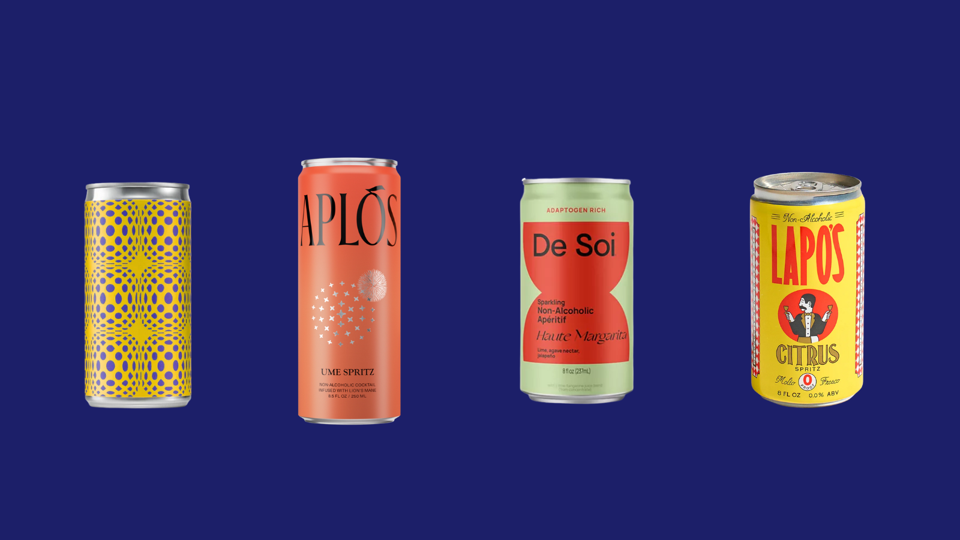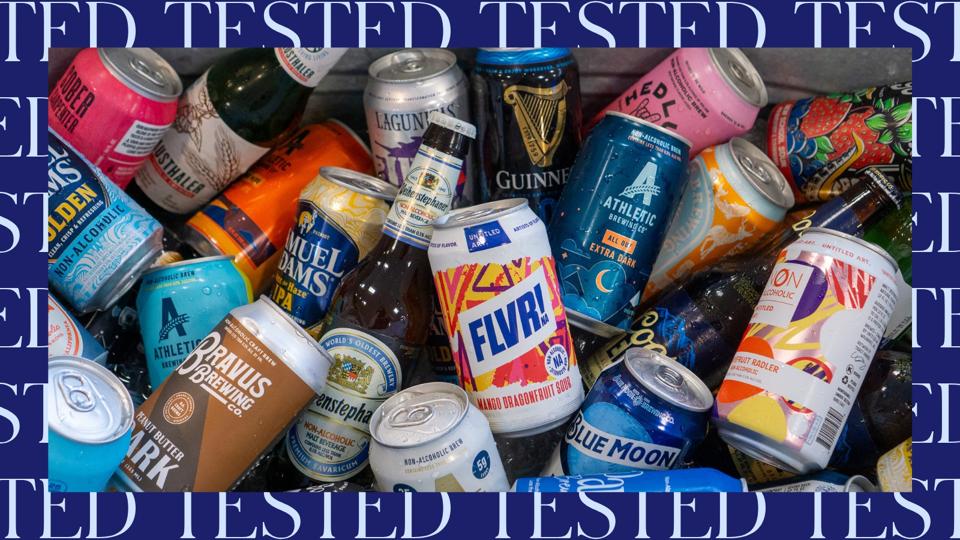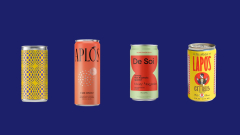The best non-alcoholic drinks feel celebratory to pop open, are complex enough to sip and are so delicious that you’ll likely keep them in your beverage rotation—whether or not you’re taking a break from drinking alcohol or you abstain from it entirely. After tasting 20 new ready-to-drink non-alcoholic cocktails (that is, premixed beverages found in a bottle or can) in 2025, in addition to tasting 30 beverages throughout 2023 and 2024, I found four new favorites that will please a variety of palates. Recent standouts include the De Soi Haute Margarita, the St. Agrestis Phony White Negroni, the Aplós Ume Spritz and Lapo’s Citrus Spritz. The list also has steadfast favorites like the St. Agrestis Phony Mezcal Negroni and the Ghia Le Spritz Sumac & Chili.

We tested 20 new non-alcoholic beverages in 2025 to find the best.
Illustration: Forbes / Photos: Retailers
Below, find our list of the 21 best non-alcoholic drinks in a can or bottle.
While you can find stellar options for large-format non-alcoholic bottles, single-serving cans or bottles are easier to transport to social functions, plus there’s no need to worry about getting ratios right. Since they’re already mixed, you’re guaranteed a delicious drink every time.
Some of the best non-alcoholic drinks closely mimic the flavors you’d expect in their alcoholic cocktail counterparts, but others are in a league all their own. If you do drink alcohol, look for flavor profiles similar to your favorite boozy beverages for your best chance of finding options you like, but keep an open mind that these won’t be direct replacements. And if you don’t drink alcohol, hopefully these picks will hold their own as lovely beverages. Since taste is subjective, too, consider my tasting notes as a guide and jumping-off point.
Finally, note that while all of the drinks I tasted are alcohol-free, some drinks labeled as non-alcoholic can technically contain 0.5% of alcohol—about as much as a banana—and many bitters contain alcohol. Accordingly, there may be some situations in which you might want to avoid these products; for example, if these drinks may get in the way of recovery, if you have a medical condition or if you are pregnant, please consult a medical professional before imbibing.
The De Soi Haute Margarita earns a place in the slate of great NA margarita offerings, thanks to its classic flavor profile. A strong hit of spice makes this drink extra enticing. While others on this list, like the Parch Spiced Piñarita and the Pentire Margarita, have woodier or smokier flavors, the Haute Margarita is straightforward and balanced. It has an unexpected but welcome kick thanks to jalapeño, and the heat lingers while you sip. Fresh and spicy, with strong lime and salt flavors coming through, there is sweetness from (just enough) agave. This drink has a strong fizz, which gives it even more of a tingle. It has a pale chartreuse color and a clean, citrusy scent.
The Haute Margarita is perfect as is, straight from the can, which speaks to how well balanced it is. This lively drink feels celebratory, but has enough spice to make it a slow sipper. It would fit in well at a rooftop pool soirée, and pair nicely with a creamy snack like elote or juicy watermelon slices.
Of the brand’s single-serving lineup, the Aplós Ume Spritz stood out for its broad appeal and unique flavors. While this drink is lighter than many NA options I’ve tried, true to spritz fashion, its ume plum flavors make it delectable. It’s floral and lightly tart. Grape, tulsi basil and ume flavors shine. It’s a sippable drink—not so sweet that you can chug it. Rather, it feels and looks elegant. Notes of warming spices like cardamom and nutmeg help deepen flavors.
The Ume Spritz smells like rose water and clover, and is a beautiful translucent pale pink; it would look lovely decanted in vintage glassware at a cocktail party. This spritz has a midsize bubble that gives the drink some extra body. It would be a refreshing pairing with savory Japanese dishes like udon or curry, but its flavor profile is malleable enough to pair with many cuisines and occasions. I’ve been dreaming of recreating an African-style peanut chicken stew that I ate at Sasaa, a pan-African restaurant in Copenhagen, and can see the light flavors of this drink balancing it perfectly.
The St. Agrestis Phony White Negroni is another hit from the brand, with a lighter, brighter take on the classic cocktail. This drink has an amazing depth of flavor upon first sip, with white grape, meyer lemon, and tarragon notes coming through, and a hint of a minty-bubblegum taste, too. There’s a very clean nose with just a light citrus scent. It’s bubbly and tart, making it easy to keep drinking. The pale yellow champagne color glimmers through the classic St. Agrestis bottles, and it also looks like a true cocktail dupe when decanted.
The juicy White Negroni would pair well with umami-rich foods like salami and taralli, or even a steak dinner. It’s a perfect beverage to add in your rotation for non-alcoholic apéro hour.
For a spritz with deeper flavors, Lapo’s Citrus Spritz answers the call. Fear not—it’s still refreshing and tasty. Flavors meld in this drink to mimic vermouth, with notes of pine, lemon rind and bark; the juniper and cloves on the ingredient list also come through. I like that this drink feels like an Americano cocktail or a vermouth and soda dupe, versus trying to mimic an Aperol spritz like many other NA beverages.
It has a very fine fizz and a golden-peachy hue. This would make a great before- or after-dinner drink, and it’s easily quaffable. Its flavors may pair well with Spanish or Italian cuisines. The crispness would compliment bitter dishes like a chicory salad or rich dishes like pizza, and its citrus notes could also lend it to t pairing well with seafood like prawns.
The non-alcoholic offerings from St. Agrestis are consistently stellar, and the Phony Mezcal Negroni iteration of their classic Phony Negroni has a layer of smokiness that I adore. It’s sophisticated and perfectly balanced, with an extra savory oomph compared to the original.
This beverage looks nearly identical to the classic Phony Negroni, too. It has a similar vibrant ruby-red color and is packaged in the iconic conical St. Agrestis bottle, as well as in cans. The hint of effervescent fizz adds a delectable bite, and is another reason why this drink tastes so much like its alcoholic counterpart. This is my go-to NA cocktail, and friends I’ve shared it with adore it, too. I recently paired it with creamy mushroom lasagna and Alison Roman’s umami-packed shallot pasta—the bitter, complex beverage held its own with these rich dishes.
Ghia’s Sumac & Chili flavor is fruity, fiery and one of my favorite Ghia options so far. The chili hits the back of your palate as you sip, and the tingly spice dominates the flavor profile. The sensation settles after a moment, though, so it doesn’t feel like your mouth is on fire. From the sumac, floral notes come through as well as fruity-tart flavors reminiscent of rhubarb or pomegranate.
This is a bold beverage, so take note if you’re pairing it with food. It would work wonderfully to sip alongside nutty, creamy dishes like cabbage topped with tahini sauce and sesame seeds, or Thai peanut noodles. It’s certainly punchy enough for a night of dancing, too. I enjoyed the Sumac & Chili as an invigorating winter drink thanks to the warming effect; I’d opt for Ghia’s more refreshing Lime & Salt in summer.
De La Calle offers a delicious, totally non-alcoholic version of tepache—a fermented beverage made from pineapple that typically has an ABV of between 1 and 3%. The company has tons of enticing flavors to choose from, or you can opt for a few variety packs to try them all. I was particularly fond of the Ginger Manzana and Pineapple Spice, which have warming spices and a gingery kick to complement the bold, zingy, tropical flavors of the drink. For a welcome note of heat, opt for the Pineapple Chili. All the cans have a light fizz that’s more delicate than a typical soda. I especially appreciate that even though De La Calle uses a non-sugar sweetener, it doesn’t taste saccharine.
De La Calle cans are 12 ounces, like a typical seltzer or soda, and come packaged in a rainbow of colors that correspond to different flavors. You can also get a pack of De La Calle on Amazon, which makes these easier to order than some other options on this list. This drink would be an ideal pairing with Latin American food, but I’d be just as happy enjoying it on its own on a sunny day of kayaking or reading by the lake. For people who don’t like bitter flavors or who are trying to avoid sugar, this fruit-forward beverage may be a good choice.
For a fuller-bodied NA drink, Eva’s Spritz is a lovely option. This beverage evokes a darker liquor, though it tastes more tea-like and fruity than fiery. It’s earthy and tannic, with notes of tart rhubarb and zesty lemon to brighten it up. While it isn’t as acidic or vibrant as some drinks I tried (and I wouldn’t compare its flavors to Campari or Aperol), it has an enticing blend of sweetness and bitterness.For Bitter For Worse bills Eva’s Spritz as an apéritif; I would also turn to this drink for nighttime gatherings and during cooler weather. I savored a spritz on a chilly winter night while prepping roast chicken and a radicchio salad for dinner. It’s a mature-tasting beverage.
Eva’s Spritz has a light bubble and pours a rusty rose color. It comes in a four-pack of small, svelte cans, like many NA drinks on this list. You can also buy a larger-format bottle of Eva’s Spritz, which would be perfect for celebrations.
Ghia struck gold with their Le Spritz Lime & Salt variety: This premixed drink adds citrus and salinity to the brand’s apéritif for a juicy, vibrant cocktail. While I find the Ghia Soda and Ghia Ginger versions of Le Spritz to be more bitter and tasting of grapefruit pith, I’d happily sip the Lime & Salt all night long. The drink is a muddy rose color, with a clean nose that smells lightly sweet and gingery. Le Spritz comes in a slim eight-ounce can with chic matte labeling.
This drink would go over well on a day spent soaking up the sun, when a little kick of salt feels welcome to quench your thirst—think: a minor-league baseball game or an afternoon of inner tubing at the river. I’d also enjoy Le Spritz Lime & Salt with richer Thai dishes like red curry or khao soi. Ghia also comes in a large format bottle, and you can get the spritzes in a variety pack.
The delicious St. Agrestis Amaro Falso reminds me of a Fernet and coke: It’s an instant classic, if not slightly polarizing. Clear brown with a big bubble, this drink has more depth of flavor than the comparable Lyre’s Malt and Cola. Rosemary, bergamot, mint and, of course, cola notes shine; a bitterness from gentian root levels everything out. While flavors are reminiscent of an amaro, this is a longer drink, and the maker compares it to an Amaro Highball. The drink is lightly sweetened, but doesn’t feel syrupy (in fact, it tastes less sweet than the brand’s equally delicious Phony Negroni).
St. Agrestis’s stunning, tapered bottles are attractive and easy to hold if you want one all to yourself; alternately, they’re perfect for sharing if you’d like to decant this drink over a large ice cube after dinner. St. Agrestis recommends garnishing with an orange twist for extra oomph. Savor a bottle over a slice of chocolate torte at the end of a meal, or nurse one yourself while you wash dishes after your dinner party.
For a mouthwatering sipper that you’ll want to enjoy all night long, opt for the Jas Paloma Libre. Founder Cecilia Rios Murrieta has a background in mezcal, and this drink is similarly complex and tantalizing, as well as smoky, salty and lightly sweet. The Paloma Libre of course tastes like grapefruit, but there’s also a bitter, woody bite from the ashwagandha. I don’t mind it, though—it counterbalances the bright limey flavors and underlying warming spices like cinnamon and cardamom. The drink has a light effervescence with hardly any bubble, so it feels more mature than a frothy grapefruit soda. It’s also less sweet than Parch’s Prickly Paloma (which is an ideal option if you prefer a sweeter drink—and there’s no shame in that).
Jas pours a light coral in color, and smells faintly of root beer. I appreciate that the drink comes in a 12-ounce can, towering over most other NA drinks I tried—that means there’s more to share, or enjoy for yourself. This Oaxacan-inspired drink is a natural fit for pairing with Latin American cuisine—I’d also love it with grilled meats and vegetables.
The Figlia Fiore Frizzante is juicy in the best way. This drink is velvety and welcoming, with notes of cranberry, nutmeg, ginger and blood orange. It also has a sour kick and a light fizz, which makes it taste complex yet refreshing, like an adult beverage should. This is the drink I want to have at Thanksgiving dinner, or while cooking a big batch of Marcella Hazan’s famous tomato sauce on a chilly fall night. The drink is a light mauve color, and comes in a svelte 8-ounce can. While you can buy the Fiore undiluted in a large bottle, the Fiore Frizzante comes spritzed and ready to drink.
The Fiore Frizzante strikes an almost impossible flavor balance, which is why I keep coming back to it. It’s not overly sweet, but it lacks the bitterness or burn that many NA drinks impart—you won’t find any capsaicin kicks or face-scrunching chicory here. Instead, the depth of flavor comes from the warming spices and acidic citrus. I also appreciate that I can’t detect any hint of preservatives or artificial flavors in this drink: For something in a can, it tastes fresh squeezed. If you tend towards more-savory drinks without medicinal or vegetal flavors, the Fiore Frizzante is a good choice.
The resemblance between the St. Agrestis Phony Negroni and the alcoholic version of the cocktail is uncanny; this was one of the only drinks I tried that truly mimics the burn of alcohol. Whether or not you want that in an NA drink is, of course, up to you. The Phony Negroni is deeply herbaceous, and those earthy flavors are balanced with cherry-cola sweetness and zesty citrus notes. Texturally, it’s thicker and more syrupy than most of the beverages I tried—and a great option if you want a little more body to your drink. Altogether, sipping the Phony Negroni makes for a highly enjoyable drinking experience.
The garnet-red liquid glows through slender glass bottles, and it’s just as enjoyable in a glass over ice as it is straight from the bottle. A very light fizz, untraditional for a Negroni, makes this drink feel even punchier. Its heady flavors make it perfect for savoring over time. I’d opt for this at a dinner out, an art opening or a holiday party any day.
A punchy heat and smokiness help the Parch Spiced Piñarita feel mature. Sweet and sour pineapple, chili, oregano and salt elevate this beverage compared to other pineapple-scented NA drinks I’ve tried. The ingredients also include mole bitters, which may explain some of the chocolatey, smoky depth. It’s a beautiful blush pink color that reminds me of a desert sunset, and comes in a slender 8-ounce can.
This drink does have a mushroomy, bitter aftertaste and a slightly woody smell (from the ashwagandha and ginseng) that may not appeal to everyone; of course, you’ll also want to skip it if you don’t like spice. On the other hand, that heat, sourness and bitterness helps mimic an alcoholic tang and burn. I’d pair the Piñarita with barbecued pulled pork to balance a meaty meal, or drink it with fish tacos to evoke margarita-like vibes. This drink would also be perfect for sipping by itself outdoors, whether at the park or pool.
For a light, refreshing, easy-drinking option, I’m a fan of Lyre’s Amalfi Spritz. This drink isn’t as layered or intensely flavored as others I tried, but for some, that may be a bonus. Like an Aperol spritz, it balances bitter, herbaceous and sweet with a big, tingly bubble that makes it a delight to drink. Orange and rhubarb notes dominate, and the drink itself is a bright, translucent coral that will glow on sunny days if you choose to pour it into a glass.
I’d reach for this during happy hour to pair with salty bites like olives, chips or pizza. The can isn’t as trendy as some, but that’s fine—it’s what’s inside that counts. Decant this with an orange twist to feel a little fancier, or throw a pack in your bag for your next picnic. Like several options on this list, you can get Lyre’s Italian Spritz undiluted in a larger bottle if you want to finetune your ratios.
Lapo’s Non-Alcoholic Negroni has entered the NA-beverage ring as another delicious negroni simulacrum. Compared to the St. Agrestis Phony Negroni, it tastes a little sweeter and less saturated with flavor, but it’s still delicious and sippable. Spice notes like cinnamon and mint pop; they’re balanced by fruity, juicy orange flavors. Similar to many of the bittersweet drinks on this list, Lapo’s would be great paired with Italian-inspired dishes or a snack board, or sipped with friends on a hot summer night.
This beverage is packed in a petite 8-ounce can with a charming label that pays homage to the Italian barman that inspired the drink. The can makes it a little more portable, and the serving size is perfect for one. It’s fuchsia-red in color with a light fizz that dissipates when poured into a glass. Served cold, there’s no need to add ice: The drink is perfectly balanced as is. Add an orange slice per Lapo’s advice for extra brightness.
Is Hop Wtr essentially a seltzer? Yes. But unlike other NA drinks I’ve tried with weaker flavors, Hop Wtr has the bitterness and piquancy that make it stand out as a worthy contender on this list. The drink is very simple: In the Classic flavor, you really just taste a bitter, slightly skunky hoppiness that’s balanced by a hit of citrus and a bite from the big bubbles. I find Hop Wtr to be both bold and refreshing, but also widely appealing since it doesn’t have some of the intense botanical flavors of other drinks I recommend here. It doesn’t taste or look like beer—it pours clear—but it does have the malty, bitter essence of it, reimagined.
These drinks are packaged in an unflashy 12-ounce can; they also have added adaptogens and nootropics. The brand offers a slew of flavors in variety packs, and I also enjoyed the fruitier Blood Orange and Peach (less so the Lime, which felt more artificial-tasting than bright). Because of their relatively simple flavor, they’re great to have on hand for tempo drinking (alternating with alcoholic and non-alcoholic beverages) or as an easy, crowd-pleasing NA option. These are a repeat purchase for me, and I stick some in the cooler when I’m hosting outdoor dinner parties or for a post-hike refresher.
The Fieldwork Supertonic Cucumber, Melon & Juniper offers a flavor profile I haven’t experienced in many non-alcoholic beverages: cucumber. The drink could evoke a Pimm’s cup cocktail, which is made with cucumbers and juniper-forward gin. The vegetal notes pair well with bitter melon and herbaceous juniper for a light, spritz-like drink. Overall, the Fieldwork Supertonic is flavorful enough to set it apart from seltzers. The drink is fairly sweet, but it isn’t cloying—it helps make it feel more refreshing (the brand’s other flavor, the Passionfruit & Orange Bitters, didn’t taste as well balanced).
Fieldwork Supertonics come in a relatively tall 12-ounce can with a pastel ombré label that gives off an Instagram aesthetic. I’d throw these in my tote for an outdoor movie night to wash down salty popcorn, or drink alongside a Caprese salad with crusty bread—the refreshing flavors make it a perfect summer drinking option. Note: These drinks have added adaptogens and nootropics, which are supposed to boost your mood, though we can’t test for that claim. Always check with your doctor if you have concerns about supplemental ingredients.
The Casamara Club Superclasico Aperitivo is branded as “cocktail strength,” and compared to the brand’s delicious but more lightly flavored sodas, this tracks. The drink reminds me of Sanbitter, an equally delicious Italian bitter drink, but the Superclasico tastes a little less syrupy and cherry-forward. This drink does a simple thing exceptionally well. Its flavors are perfectly balanced between warm spices, bright citrus notes and bitterness, and offer more body than the similar bitters-and-soda-inspired canned cocktails I’ve previously tried. The drink has a translucent and salmon pink color with a light bubble; when you pour it into a glass or over ice, it fizzes nicely.
The small can with its retro-inspired branding feels cheeky and cute. This drink isn’t as strong as others on this list, so it may be nice for people searching for more mellow but still delicious drinks. True to its aperitivo designation, it would be great for happy hour paired with crunchy snack mix and olives. I’d be just as happy having the refreshing Superclasico to balance out a rich meal like moules frites as I would with a light, summery supper of panzanella.
I’m impressed by how fresh tasting the Pentire Margarita is, especially for being in a can. This non-alcoholic margarita is more traditional than Parch or De Soi’s take on the drink, and much more so reminiscent of a classic margarita. Puckery lime juice dominates, countered by a hit of smoky, lingering chili and a salty bite. The scent is clean and citrusy. While there’s no burn from alcohol, the sourness and spice take effect; the flavors stayed on my palate and left me wanting more. There’s also no fizz here, and this is one of the only flat non-alcoholic cocktails I’ve tested. But it works—the drink is juicy and vibrant straight from the can. Still, I’d prefer to drink the Pentire Margarita on ice, with a salt or Tajin-coated rim and extra citrus and herb garnishes to liven it up even further.
Both of the canned Pentire cocktails (this one and the paloma, described below) come in sleek 200ml cans with matte wrappers that are easy to hold onto. Pentire also makes a bottled version of their margarita in various sizes. The piquant drink would pair brilliantly with chips, queso and guacamole while watching your favorite sports team or hanging out on a patio with friends.
The Pentire Paloma tastes complex, juice forward and not too sweet, helping it land a spot on this list. Similar to the Pentire Margarita, this drink was surprisingly fresh-tasting for being premade. The Paloma is a straightforward drink, and this non-alcoholic version is a good dupe. There’s a woody, herby undertone to the sunny, bittersweet grapefruit that makes it intriguing to sip on. A hint of salt helps flavors sing.
The drink is a beautiful color—the palest cloudy pink—and has a light fizz. Both of the canned Pentire cocktails come in sleek 200ml cans with matte wrappers that are easy to hold onto. This cocktail is mellow enough to pair with a range of foods or scenarios. Since it’s on the lighter end of the NA cocktail spectrum, I think it would be a great complement to hearty Latin American foods like mole or sopa de pollo.

Other Non-Alcoholic Drinks I Tested
The world of non-alcoholic drinks continues to expand: I see dozens of new offerings emerge each year. If none of the recommendations above suit your tastes, check out some notes on other products I tried below—many are delicious. And always remember that a local NA beverage store or bar (if you have one in your area) is an excellent avenue for trying new products.
In 2025, I tasted an additional 20 drinks to update this piece. The Aplós Chili Margarita, Aplós Mandora Negroni, Curious No. 6 Pineapple Painkiller, Curious No. 8 Black And Blue Amaro, Mockly Eye-Opener, Kin Bloom, Kin Luna Morada, Kin Actual Sunshine, Pathfinder Spritz, Pathfinder Negroni, Recess Grapefruit “Paloma” and Brēz Flow did not make the list. These drinks didn’t have flavor profiles that were as exciting, well-balanced or as broadly appealing as winning drinks. That said, if they appeal to you, don’t hesitate to give them a try. Other drinks that were honorable mentions are listed below.
De Soi Spritz Italiano: Rose-colored and light-bodied, this drink mirrors an Aperol spritz. It has a light body and a relatively sweet flavor, with notes of lemony brightness. While it isn’t as complex as some other NA spritzes I tried, I’d be happy to sip this outside on a summer day.
Aplós Kola Fashioned: This heady drink is a close old-fashioned dupe. Strong warming spices like allspice and black pepper come through, and it has a woody, peaty taste, almost like a scotch. If you prefer deeper flavors, you may enjoy this drink.
Parch Desert Margarita: This juicy margarita tastes like mangoes and tangerines, and has a hint of salt. It was sweeter and juicier than other NA margaritas I tested, but you may prefer that. Overall, flavors are more straightforward than other drinks I tested.
Pentire Coastal Spritz: Though I’d happily drink this spritz if someone served it to me, it has a woody aftertaste that doesn’t match the refreshing, juicy flavors I crave in a spritz.
St. Agrestis Phony Espresso Negroni: This is another fun take on a negroni from St. Agrestis, but it wasn’t my favorite among the ones I’ve tried. The espresso liqueur tasted cloying with the sweetness of the drink; it felt like too many bold flavors were competing. If you love coffee, though, consider adding this to your Phony Negroni lineup, or try a variety pack.
For Bitter For Worse Rose City Fizz: This drink is jammy; I enjoyed the concentrated flavors, but they might be overpowering to some. Like Eva’s Spritz, it’s tannic and has an earthiness to it. Fruit flavors like elderberry dominate, and I detected hints of Douglas fir and hibiscus. A smokiness—think: oolong tea—is layered in.
RSRV Collective Kenshō Orana: The Kenshō cocktails were overwhelmingly sweet to me and lacked the complex flavors of the winners on this list. Of their options, I found Orana the most intriguing—it’s one of the only orange-flavored NA drinks I’ve tried. It has warming cinnamon flavors that work well with the citrus.
Ghia Le Spritz: Ghia’s original Ghia Soda and Ghia Ginger taste nearly identical, and they may be best for people who love bitter flavors (grapefruit pith and ginger dominate). I prefer the Lime & Salt, which tastes more vibrant. Ghia also comes in a large-format bottle of the aperitif alone.
Curious Elixir No. 2: This tasty pineapple-flavored drink is similar to the Parch Piñarita, but it’s a little sweeter and has a back-of-the-palate spiciness that made my nose tingle. I preferred the smokiness and depth of the Piñarita, but the Curious No. 2 is a zesty, refreshing NA beverage that I enjoy. It comes in a larger bottle that’s designed to have two servings. Curious makes a wide range of flavors if something else sparks your interest.
Curious Elixir No. 1: Fruit-forward and sweet, this pleasant cocktail may be a good option for those looking for a juicy NA beverage. I particularly liked the fennel flavor, which gives this drink a unique twist.
De Soi Can Variety Pack: The concoctions from De Soi are surprising and enticing; I think this variety pack is a great investment if you’ve already sampled some NA cocktails and are looking to try something new. Still, the flavors may be more divisive compared to other drinks I tried. I especially enjoyed the De Soi Purple Lune, which has a deep, earthy berry flavor and a light sparkle. The notes of tannic tea, turmeric and lemongrass of the Golden Hour variety were also unique amongst drinks I tried, but may be too biting for some. I’m less inclined towards the Champignon Dreams, which tastes like a surreal blend of dried mushrooms and strawberry candy. De Soi also comes in larger-format bottles.
Parch Prickly Paloma: If you’re looking for a fruity and refreshing NA drink, the Prickly Paloma may be for you. I found it overly sweet, but it still had some floral and salty notes that helped make it balanced and very drinkable.
Lyre’s Classico: Perhaps I should’ve known from the branding, but this tasted like a wine spritzer and not a cocktail. It’s champagney and effervescent. Flavors are punchy with notes of pear and apple. I detected a slightly funky aftertaste, and ultimately prefer the brand’s zippier Amalfi Spritz.
Lyre’s Malt And Cola: Compared to other similar drinks I’ve tried, this was fairly one note: Bubbly and dark brown, it’s like a slightly spicier root beer. It lacks some of the more nuanced herbal layers that I loved in the Amaro Falso from St. Agrestis. The malt flavor comes through, and the drink is pretty sweet.
Spiritless Old Fashioned: I enjoyed this drink—notes of caramel, oak and vanilla shone, and it was one of the few drinks I tried that mimicked a darker spirit. There’s no fizz here, so it feels truer to an Old Fashioned. But I puzzled over a faint scent and aftertaste that, frankly, evoked Play-Doh.
To see if I could get around this (again, it’s a faint taste, and I’m very sensitive), I poured the drink over ice, added an orange twist, and squeezed a little lemon into the drink. It brightened it up and made it much more enjoyable; it’s worth taking a few extra steps to liven up this drink if a boozeless Old Fashioned is truly what you want. Spiritless also makes large-format bottles.
How I Tested The Best Non-Alcoholic Drinks
To test the best non-alcoholic drinks, I focused on tasting best-selling options from NA retailers and recommendations from experts. For our 2025 update, I tested 20 drinks. I tried each one over the course of a week, sipping water and eating saltines in between tastings to cleanse my palate. I also decanted each beverage into a glass to assess how it looked and smelled, and to get a sense of its texture. (For example, did it have a big, bright bubble or a light, tongue-tingling fizz?) As I tasted, I considered how well each drink was balanced. Since complexity is a crucial element in the best non-alcoholic drinks, I tasted for layers of flavor like sweetness, bitterness, spice, sourness and piquancy (reminiscent of the sensations that Derek Brown, the non-alcoholic beverage expert I interviewed for this story, says gives alcohol its signature burn or kick). I did this same tasting process for the original piece in 2023 and in our 2024 update.
To test the best non-alcoholic drinks, I focused on tasting best-selling options from NA retailers and recommendations from experts.
Anna Perling For Forbes
Drinking is experiential, so I also considered every beverage’s package—how it arrived and how it was presented in its can or bottle. I also looked at the ingredient list to get a sense of what went into each drink.
Note that for this review, I focused on single-serving options: premixed drinks that come in a can or bottle. There are countless iterations of NA drinks in other formats beyond single-serving cans and bottles, including wine, beer, spirits and unique elixirs that defy categorization and are worth exploring. I also skipped drinks with added CBD or other hemp products, since it’s not possible to accurately test for the effects of these compounds at home.
How To Choose The Best Non-Alcoholic Drinks
Why You Should Consider Non-Alcoholic Drinks
NA drinks provide delicious beverage options to have on hand, whether you want to totally abstain or simply drink mindfully to pace yourself. There’s been a steady increase in interest surrounding these drinks; not only are drink sales soaring, but there’s also been a rise in resources, stores and bars specializing in non-alcoholic options. Plus, people are expressing a desire to drink more intentionally.
Derek Brown, founder of wellness company Positive Damage Inc. and author of Mindful Mixology: A Comprehensive Guide to No- and Low-Alcohol Cocktails With 60 Recipes, introduced me to a new-to-me term during our interview: tempo drinking, which he said he learned about during the 2023 International Wines and Spirits Record conference. The phrase refers to alternating non-alcoholic, low-alcoholic and alcoholic drinks to lessen intoxication, while still enjoying delicious beverages. “It’s setting a pace the way you want to do it,” he says. “That aspect [allows for] mindful drinking, being aware of the choices that you want to make.”
In 2025, I tried 20 new drinks to see what was new and notable in the world of non-alcoholic drinks.
Anna Perling For Forbes
When you’re perusing non-alcoholic options, consider what you like to normally drink, and opt for similar flavor profiles. If you’re an alcohol drinker, keep an open mind about expanding your horizons as opposed to finding a direct replacement for alcohol. “So many people already have their favorite whiskeys or their favorite bourbons and they’re not quitting drinking altogether,” says Aqxyl Storms, co-owner of the non-alcoholic bottle shop Minus Moonshine in Brooklyn and another expert I spoke with for this story. “So maybe add some spirits that aren’t trying to replace what you love to your bar cart—try something to add into your selection.”
What Makes The Best Non-Alcoholic Drinks
There is a wide range of non-alcoholic drinks: cocktails, spirits, wines, beers, shrubs and more. When we spoke, Brown pointed out that there is a difference between a non-alcoholic cocktail (though the definition may vary, here we’ll describe these as a mixed drink with a set of sensory components that make it taste complex and exciting) and a non-alcoholic drink (which can include beer, wine, shrubs, bitters, seltzers and more). Still, he said there are certain sensory elements to look out for to ensure deliciousness in both categories: intensity of flavor, piquancy, texture and length. While other mixologists may differ slightly in defining what makes a great NA drink, these principles resonate. Here’s a breakdown of what each of these terms mean:
Intensity of flavor: First, intensity of flavor will help make a memorable drinking experience. This means an NA cocktail will have stronger and more layered flavors than, say, a traditional flavored seltzer. “Whether you’re drinking a gin and tonic or a Manhattan or a non-alcoholic version thereof, they all have that intensity of flavor.”
Piquancy: This is the kick you might get from alcohol in a drink, or a spicy hit of pepper or sourness from acid in an NA beverage. “Somebody once described it to me as the stomping power of the drink,” Brown says. “It’s something that makes you stop and think…It lights up your brain, but in a very different way than just lemonade per se.”
Texture: Alcohol also has body—due to its molecular composition, it’s thicker than water. Some non-alcoholic drinks will mimic this texture with specific additives; they may be syrupy, cloudy or otherwise thickened. Others may add effervescence to evoke the tingle of alcoholic drinks.
Length: Lastly, Brown says to consider length, or the amount of space alcohol takes up in a drink compared to mixers. In premixed NA beverages, length has been determined for you—that’s part of what makes them consistently delicious and easy to imbibe. If you opt for a larger-format bottle, you can play around with ratios to whip up a drink that suits you.
Why Choose Ready-To-Drink Cocktails Vs. Large-Format Bottles?
A main appeal of ready-to-drink non-alcoholic cocktails is that they’re already made: Simply pop the top and start sipping. “I want it ready for me,” says Storms. “I want to pour it over ice, I want to sit down, and I want a pretty drink in a glass that I had to put zero effort into.”
Premixed non-alcoholic drinks will be consistently delicious, and you won’t have to worry about having extra ingredients on hand. They’re a great option if you’re exploring the world of NA beverages or want to try different drinks before committing to a larger, pricier bottle format. My local NA bottle shop, The Zero Co., offers loose cans and bottles so you can build your own sample pack before committing to a four-pack or bigger from one brand.
Another advantage to ready-to-drink options is that they’re portable. “If you’re going to a party and there’s going to be nothing there for you, you can just drop a couple of those in your bag and then you know there’s going to be ice and a cup,” says Storms.
On the other hand, many ready-to-drink cocktails lack a certain freshness that you get with a beverage made à la minute. To combat this, however, Brown advises garnishing a premixed drink with herbs or fruit, pouring it over a large ice cube or adding a splash of citrus juice to liven it up. In addition, most brands have advice on their websites for elevating their drinks to the next level.
Other Resources For Learning About Non-Alcoholic Drinks
To learn more about non-alcoholic drinks, you can look to writers, online resources, brick-and-mortar stores, online retailers and events. You can also increasingly try non-alcoholic cocktails at bars and restaurants that offer premixed NA drinks in bottles and cans in addition to their own cocktail creations.
If you have access to a brick-and-mortar non-alcoholic bottle shop, you may be able to taste drinks before you buy, avoid shipping fees and get tailored recommendations for your tastes. Storms says the shop hosts free events where people can socialize without any alcohol present and try different beverages (and if you don’t live in the area, you can order drinks from the shop online). At The Zero Co., the team offers tastings (as well as ready-to-drink options) to help lower the barrier to entry, since NA drinks can be expensive. The shop has a bar cart with open bottles that customers can sample, and offers a build-your-own pack of ready to drink NA options. And if you don’t live near an NA store, don’t fret. There are a number of online retailers that ship, including No & Low and The Zero Proof; you can also buy most drinks directly from the maker.
As the non-alcoholic space grows, dynamic reading materials, resources and experiences continue to emerge for people who want to enjoy NA drinks. Malory Atkinson, co-founder of The Zero Co. bottle shop, recommends Julia Bainbridge’s book Good Drinks for those looking to learn more about the NA space and try their hand at making drinks at home.Spirited Away, an NA bottle shop in New York, launched a crowdsourced review platform called Dry Atlas where shoppers can get a sense for NA drinks, as well as a newsletter, High Spirits, that it took over from Bainbridge. Further, Brown has launched a festival, Mindful Drinking Fest, where gatherers can sample new beverages.
And that’s just the tip of the iceberg: Storms says they are looking forward to the future of NA drinks. “What I’m really excited for is that beverages just keep getting better and companies keep cranking out the good stuff,” they say. “Yes, we have non-alcoholic whiskey and tequila replacements, but what are they going to taste like in 10 years?”
My Expertise
I have been reviewing non-alcoholic drinks for over four years, and have tried over 131 options during that time. I wrote one of the first comprehensive guides on the topic. For this update, I did a comprehensive sweep of the NA beverage world to see what was new and notable to test. I have also edited our guide to the best non-alcoholic beers.
Beyond that, I have been writing about food and drinks for over eight years for publications including Wirecutter, Kinfolk and Saveur. Currently, I am the senior reviews editor here at Forbes Vetted, where I guide our tested content.
I also consulted several experts while writing this piece to hear their opinions on what makes the best non-alcoholic drinks, and to learn about new and notable options in this ever-expanding industry. To learn about what makes a great NA beverage, I spoke with Derek Brown, founder of wellness company Positive Damage Inc. and author of Mindful Mixology: A Comprehensive Guide to No- and Low-Alcohol Cocktails With 60 Recipes. To get a sense of the NA scene, I interviewed Aqxyl Storms, founder and co-owner of the non-alcoholic bottle shop Minus Moonshine in Brooklyn, New York. I also visited my local NA drinks store, Atlanta’s The Zero Co, where I spoke with co-owner Malory Atkinson.





